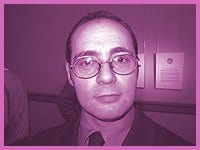The demise of Making Scenes has left Ottawa without a queer film and video festival for the first time in more than 12 years.
And although many point to the festival’s financial problems as the reason behind its untimely death, some of those involved in Making Scenes – in particular former executive director Dan Grummisch – have wondered aloud if there is still a need for a stand-alone queer film festival in Ottawa.
In May, citing increased sources of queer visibility within the mainstream media, Grummisch questioned the festival’s future purpose, telling Capital Xtra, “What we want to do – and what the festival was originally designed to do – was present queer images, but you see those all over the place now.”
But many within the media arts community say that not only does the need for queer film festivals remain strong, the interest in them – in both the straight and gay communities – is blossoming.
And queer artist Carl Stewart, who served as Making Scenes festival coordinator several years ago, says it is important for queer images to be generated from within the gay community itself.
“If we’re going to look to mainstream television for accurate depictions of our lives, then that’s kind of a sad statement,” he says. “We need to be responsible for telling our own damn stories.”
Scott Ferguson, executive director of Inside Out, Toronto’s gay and lesbian film festival, says such festivals are important because they help to foster that sense of queer community in a city.
“There is a real need and importance for the sense of community you get at a festival,” he says. “You know, there is nothing like sitting in a movie theatre with 300 other queer-identified or queer-supportive people, and seeing a film up on screen and being able to interact [with each other] afterwards – or interact with the artist. And you are just not going to get those kinds of experiences outside of a film festival.”
Matt Salton, head of communications for Reelout Queer Film And Video Festival, says attendance at the annual Kingston event has been steadily increasing since its beginnings at the back of a bar in 1999.
“We’ve seen our audience grow exponentially every year,” says Salton. “And our demographics have shown that we attract a large number of queer patrons, but also a sizable crowd that identifies as heterosexual.”
Salton adds that although gay and lesbian images have become a staple of the mainstream media, “that doesn’t mean that interest or the purpose of a queer film festival is obsolete.
“Our particular niche provides a broader range of media arts that include short films, video, experimental work, documentary, independent feature-length films. This creates a forum to engage in discussion and debate on the issues that relate to the practice of film and video making, as well as the queer community,” explains Salton. “You’re also creating an opportunity for queer artists throughout the world to showcase their art and get paid.”
Ferguson agrees that without queer festivals, a lot of work will go unseen.
“There is a lot more access to queer work on television, in movie theatres and DVD – and just at other film festivals and such too – but I look at the work we present and for every 25 films we show, maybe [only] one of them is going to have some sort of exposure in another outlet,” says Ferguson. “There is still just so much work out there that’s not being shown that quality-wise should be shown. So, just in terms of artwork, I think that there is still a need for [our own festivals].”
Stewart says that the lack of a film festival will be a major setback for local filmmakers, as Ottawa artists lose another much-needed opportunity to showcase their work.
“It is one more venue that is no longer there and that’s really sad,” Stewart says. “And we’ve seen that not just in terms of film festivals, but in all sorts of venues for artists.”
Tracey Clark, who served as the president of Making Scenes during the mid-to-late 1990’s, says although the festival may have outlived a full-time focus, there remains a concrete purpose for a queer film festival in Ottawa.
“There still is, I think, [the need] to show the edge or the independent in the short film category, because we don’t see that stuff – you can’t get access to that stuff,” says Clark. “If it’s going to be resurrected it needs to transform its purpose or find kind of a complementary home.”
But Stewart says once an artist-run centre is gone, it can be extremely difficult to restart.
“It’s an enormous amount of work, and you build from one year to the next and you gain a momentum, and people look forward to it,” says Stewart. “If it is suddenly not there, then I think that it really quickly goes out of people’s consciousness. And it’s a real sad fact that it just may never be there again.”
But while the solution to how best to rebuild Making Scenes – or even create a new queer film festival in Ottawa – remains up in the air, Salton has three words of advice for those looking for a well-grounded starting point: “Rally, rejoice, rebuild!”

 Why you can trust Xtra
Why you can trust Xtra


